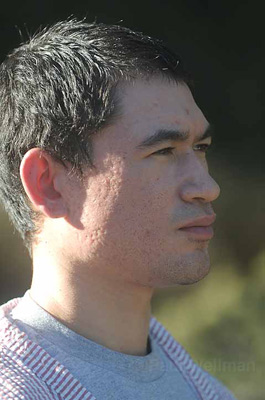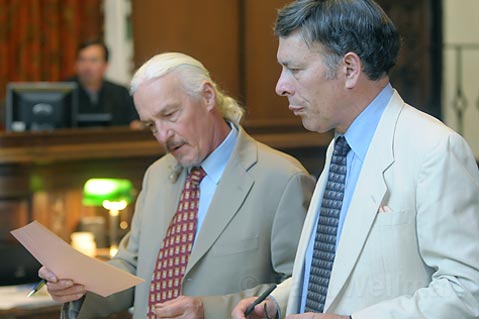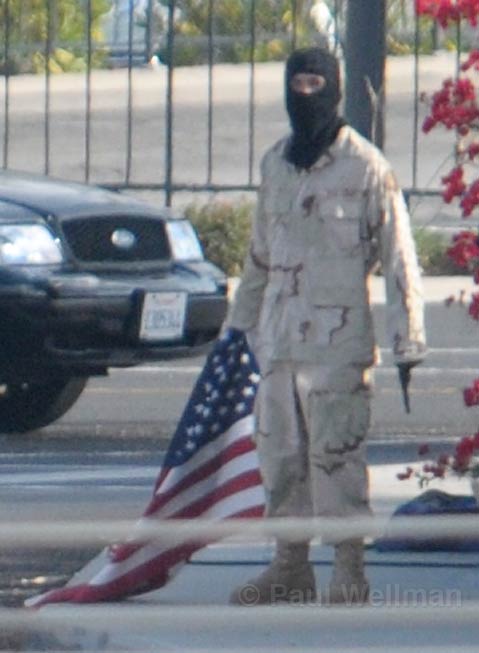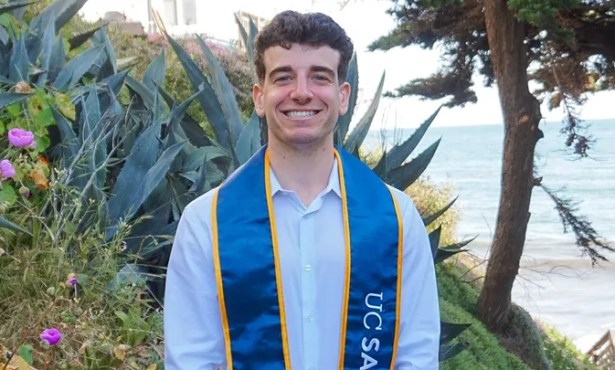Van Tassel Prelim Hearing Scheduled for Feb. 5
Overpass Gunman Currently in Locked Veteran's Hospital

The convoluted case of Edward Kyle Joseph Van Tassel-the famed La Cumbre overpass gunman whose November 3 standoff with Santa Barbara police ended peacefully but literally stopped Highway 101 traffic – finally made definitive progress on Wednesday afternoon.
After months of back-and-forth concerning Van Tassel’s psychiatric care, which is now being handled exclusively by the Greater Los Angeles Area Veterans Administration Healthcare Facility, Judge Brian Hill scheduled the preliminary hearing for Thursday, February 5. Aaron Levy, the man who allegedly dropped Van Tassel off at the overpass where Van Tassel eventually waved an unloaded gun in support of then-presidential candidate Barack Obama, is being charged as an accomplice, and his case will be heard on February 5 as well. A major change in the case is that it will now be heard by Hill, after prosecutor Darryl Perlin filed a disqualification for Judge George Eskin, who had been hearing the case. Defense attorney Robert Landheer objected to the disqualification, saying it was not filed close enough to the beginning of court proceedings, but Eskin upheld it and passed the case on to Hill.
The road to this setting of Van Tassel’s preliminary hearing has been fraught with twists, turns, and detours, from the lowering of Van Tassel’s bail from $250,000 to $50,000 -which was contested by Perlin – to an incident involving Van Tassel’s unsanctioned visit to the home of actor Tom Cruise while he was being held at a less secure facility in West Los Angeles. Currently, Van Tassel is a patient in the locked psychiatric wing of the VA hospital in Los Angeles, with the VA having been appointed as his conservator by the Los Angeles Superior Court on January 13. As conditions of his bail, Van Tassel is required to remain in the facility and to follow the treatment and directions of the VA. “If he doesn’t do as he’s directed by his conservator, he’ll have to go back to jail,” said Perlin, who had been adamant that Van Tassel stay put in the more secure veterans facility he was initially sent to when he was released on bond on November 12.
It was during the time he spent at the less secure facility, however, that Van Tassel made several trips to Cruise’s home, with the expressed intent of delivering a letter attempting to persuade the famous actor to take up the cause promoting the welfare of troubled veterans. “I wasn’t going to Tom Cruise’s house as some crazy fan, but because [veterans] need a voice so that America can hear those words,” said Van Tassel in an interview, noting that he thought Sean Penn or some other well-known figure would have been equally effective at delivering the message. “God put me in the vicinity of Tom Cruise,” Van Tassel explained.

However, his failure to remain in the facility at all times as agreed upon in court was not taken lightly by Eskin or Perlin, and Van Tassel was quickly transferred to a locked facility at the main VA hospital. Conservatorships, Perlin explained, are often granted over elderly and mentally ill patients who are deemed by the court to be no longer able to care for themselves. He continued that this one could technically remain in place indefinitely, or as long as the VA sees fit to maintain it.
Van Tassel’s mental history may prove to be a deciding factor in the case’s outcome. Having joined the Army a month before the U.S. invasion of Iraq, Van Tassel spent a large part of 2004 and some of 2005 stationed there, ultimately returning home to Walter Reed Army hospital and being diagnosed with Post Traumatic Stress Disorder (PTSD) during in late 2005. In October 2005, he was honorably discharged from the Army, only two and a half years into his four-year enlistment. His time in Iraq left a significant emotional impact on him, Van Tassel said, but talking about it is the best way for him to heal. “The only way to get over the things we saw and did is to talk it out, let it out, and get it out, as they say,” he said.

Willing to share some of his wartime experiences during a break between court sessions on Wednesday, Van Tassel recounted how his team was instructed to shoot at targets with their Bradley Fighting Vehicles without knowing what they were shooting at. Then, he said, they had to clean up the bodies of women and children – people he said had nothing to do with the insurgency. Another disturbing event he recalled was when he pulled the upper half of a buddy’s torso out of a Humvee after an Improvised Explosive Device attack. “His blood flowed like water,” he said. “When you know someone’s name and get to know them, your world can be changed by one explosion.” He also complained about the effects of being under fire for a period of time. “Everything that sounds like a boom or a clang brings shudders and you don’t feel normal anymore. When you get back [to the U.S.] they give you medications that they don’t know the side effects of.”
Medication is a prominent part of Van Tassel’s current treatment in the VA psychiatric facility, and he was noticeably affected by Lithium and other medications during his court appearances. People who had not seen him since his last court appearance said that his face looked a bit puffy, and he seemed slightly more detached in his speech than during visits this reporter had made to the VA facility around Christmastime. However, Van Tassel said that the treatment center isn’t a bad place, only that it needs significant improvement to be more effective. “I think the VA is one of the best broken organizations around – it’s in need of repair,” he said, adding that more and better-paid staff would equal better treatment for patients there. Due to overextension from long working hours, he said that many VA employees he has interacted with are unable to do their jobs properly, and that they often take out frustrations on their patients. He also cited what he perceived as lax hiring practices as another factor contributing to the VA facility’s currently unsatisfactory state.
Van Tassel seems to have a long road ahead of him, both legally and as far as his continuing mental health treatment goes. Perlin, who at the beginning of the legal proceedings appeared skeptical that Van Tassel was suffering from PTSD – at one point being taken to task by Eskin for referring to Van Tassel’s “so-called” PTSD – said that his hope is that the best interests of the people of California are represented. “We’re going to have to take this one step at a time now,” he said. “Our objective here is to see to it that justice is served.” Perlin, who said he has a reputation as a tough but fair prosecutor, stressed that he is not looking at this case in terms of punishment at this beginning phase. “That’s putting the cart before the horse.”
CORRECTION: An earlier version of the story incorrectly said that Perlin wanted Van Tassel in a less secure facility. It has since been corrected to say “more secure.”



